- PEACE FLAG
- Any one of a number of flags designed to symbolize peace as, for example, those illustrated below (see also
rainbow flag).
![[Peace flag]](../images/v/vx-pea-syr.jpg)
![[Peace flag]](../images/v/vx-gb}peace1.gif)
![[Peace flag]](../images/v/vx-de}dove.gif)
World Peace Flag;
Variant of the Rainbow Flag; Variant of the
Dove of Peace Flag
- PEAK
- 1) The highest point of the gaff to which the ensign of a warship is shifted
(moved), when it is said to be flying at the peak or at the peak of the gaff – see
shift colours (also ensign
and gaff).
- 2) A colloquial synonym (although technically incorrect) for the top of a
normal flagpole (see truck 1) and
finial).
Notes
a) With regard to 1), the practice
of shifting the ensign became necessary in the sailing era due to the introduction of a lower spar to the
mizzen gaff sail, whilst in modern warships the ensign is shifted from an ensign staff to
the peak of the gaff for reasons of tradition or operational requirement
(see also ensign staff).
b) Also with regard to 1), whilst underway non-naval sailing vessels have the option of flying their ensigns from the peak of the gaff if fitted, or from
two-thirds the way up the leech of the mainsail if Bermuda rigged – see
leech – however, the ensign should always be
returned to a staff at the stern when the vessel is at anchor or berthed alongside.

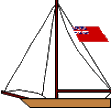
Ensign At The Peak; Ensign Flown At The Leech
- PELICAN IN HER PIETY
- See in her piety.
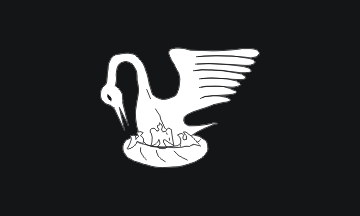
Flag of Tal-Pietà, Malta
- PENCEL (or PENCIL)
- 1) Term, now obsolete, for a narrow ribbon attached below the head of a
lance or spear (see see also banderole 2),
banderole 3) and
lance pennon 1)).
- 2) See pennoncel.
- PENDANT
- An obsolete spelling of pennant – see
pennant 2).

The Budgee Pendant c1700, England (CS)
Please note that this dictionary uses
the above term first when referring to obsolete designs or patterns of this
type – see budgee pendant,
common pendant,
man o'war pendant,
pendant coupe,
pendant number and
pendant of distinction.
- PENDANT, THE
- In British RN usage, now obsolete, the original term for a commissioning or masthead pendant/pennant
– see masthead pennant 1) and
pendant.

Red Commissioning Pendant, England then UK c1630–1864 (CS)
- PENDANT COUPE
- In British RN usage now obsolete, an alternative term for what later became known as the code
or answering pennant – see code pennant (also
pendant).
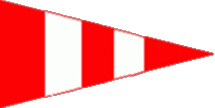
Pendant Coupee/Answering Pendant c1920
- PENDANT (or PENNANT) NUMBER
- The term was originally used for the group of signal flags/pennants
unique to an individual naval vessel, and raised to indicate that any
subsequent signal hoist was sent from or was intended for that vessel and for no others,
it is now – as a pennant, registration or hull number – a combination of
letters and numbers that identify a particular vessel within the naval
structure (see also call sign hoist,
make her number,
private signal 3) and
signal flag).
- PENDANT (or PENNANT) OF DISTINCTION
- The original 17th/18th century English/British naval term, now obsolete, for
a commodore’s broad pennant (see also
broad pennant,
budgee pendant and
pendant).
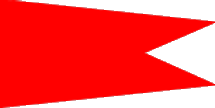
Pendant of Distinction/Broad Pendant 1674–1864, England then UK
Please note – not to be confused with the distinction pendant used in Marryat’s code – see
distinction pennant.
- PENDANT (or PENNANT) OF INDEPENDENT COMMAND
- See
common pennant.

Common/Tricolour Pendant, England/UK 1661–c1650
- PENDO
- A medieval term, now obsolete, for a pennant or small flag.
- PENNANT
- 1) A general (and imprecise) term for flags which are not strictly rectangular.
- 2) A flag which will usually narrow in width between the
hoist and the fly, and which may be triangular, square-ended or swallow-tailed
(see also flag 2),
pavon,
swallow-tail(ed) and
trapezoid).
See supplemental note and the notes below.
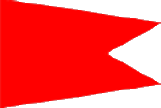


Notes
a) With regard to 2), the following modern flags
can fall into this category: broad pennant,
burgee, pincel,
club pennant,
command pennant,
guidon,
lance flag,
masthead pennant and others, as do obsolete
(or increasingly obsolete) forms such as
cornet, pavon,
pennon and pensel, and it is strongly suggested that the
more precise terms (as defined separately herein) are to be preferred in description.
b) One common denominator,
which distinguishes a pennant from a flag (as defined in flag 2)
as referenced above), is that the former is usually secondary
to the latter, and differs from it in shape, size and/or in the manner of display.
- PENNANT OF COMMAND
- See masthead pennant 1).
![[example]](../images/v/vx-de~com.gif)
Pennant of Command/Kommandowimpel of Germany
Please note that this term is an adaptation of the
German "Kommadowimpel" since its exact translation of "command pennant"
carries a differing meaning in English vexillogy and is
separately defined herein – see command pendant.
- PENNANT OF ENGLAND
- See English Pennant.
- PENNANT OF SCOTLAND
- See Scottish Pennant.
- PENNANT OF WALES
- See Welsh pennant.
- PENNON
- 1) See fanion 2).
- 2) See lance pennon 1) and
badge pennon.
- 3) In official Scottish usage, a 120 cm long pennant that is either triangular in form or has a rounded point,
and which may be granted by Lord Lyon King of Arms to any armigerous person who applies – but see
guidon 3) (also
armigerous, badge pennon and
pinsel).
- 4) At sea, an increasingly obsolete term for a small pennant.

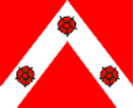

Fanion/Convoy Flag according to NATO Regulations;
Lanes Pennon of Sir Robert Knolles, England c1460 (CS); Lance Pennon, UK c1840 (CS)
- PENNONE
- An obsolete spelling of pennon – see lance pennon 1).
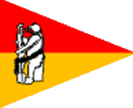
Pennone/Badge Pennon, England c1460
- PENNONCEL (PENNONCELLE, PENICELLUS or PENNUNCELLUS)
- 1) Generically the alternative terms, now obsolete, for any small flag (usually) carried on a lance
in the medieval period – a pencel – but see badge pennon
and 2) below (also
badge in heraldry,
livery colours, and
lance pennon 1)).
2) Specifically those terms, now obsolete, for an armigerous swallow-tailed lance pennon –
see pennoncier.
Please note, evidence would suggest that in the early Post-Medieval period (the 16th c.) the above
terms were also used to describe what might later be termed bunting – see bunting 2).
- PENNONCIER
- The medieval term, now obsolete, for a knight who bore an armigerous,
swallow-tailed pennon on his lance and was, therefore, below the rank
of banneret – a knight bachelor – see pennoncel 2) (also
armigerous,
badge pennon,
banneret 2) and
lance pennon 1).
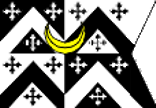
Lance Pennon of a Pennoncier (or Knight Bachelor), England 1415
- PENSIL
- See pinsel.
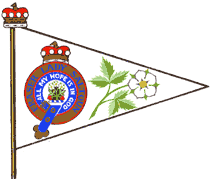
Pensil/Pinsel of the Clan Fraser (Fraserchief) (fraserchief.co.uk)
- PENTAGRAM
- A hollow five-sided (star-like) figure – but see Magen David
and its following note.

Flag of Giebenach, Switzerland
![[Peace flag]](../images/v/vx-pea-syr.jpg)
![[Peace flag]](../images/v/vx-gb}peace1.gif)
![[Peace flag]](../images/v/vx-de}dove.gif)




![[example]](../images/v/vx-de~com.gif)














